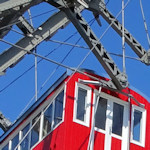Most of the iconic locations from The Third Man still exist today, though many look a little different now. Enjoy the photos as we go on a journey through war-torn Vienna…
- Iconic scenes feature the Ferris wheel, Josefsplatz, Hoher Markt and the doorway on Schreyvogelgasse
- See also:
Where was The Third Man filmed?

(The legendary Riesenrad)
One of the greatest movies of all time tells a tale set in Vienna in the immediate aftermath of WWII, with the outdoor scenes (and many interior ones) shot on location in the city.
Since filming of The Third Man took place in the late 1940s, Vienna looked pretty much as it should (rubble included), having yet to rise from the ashes of aerial bombing and the 1945 battle to “liberate” the city.
I’ve put the locations described below in the map at the end of the article. And I’m going to assume some familiarity with the plot and film. So…
(Warning: contains spoilers)
First scenes
Many of Vienna’s landmarks appear throughout the movie, though often in a pitiful state when compared to today’s city.
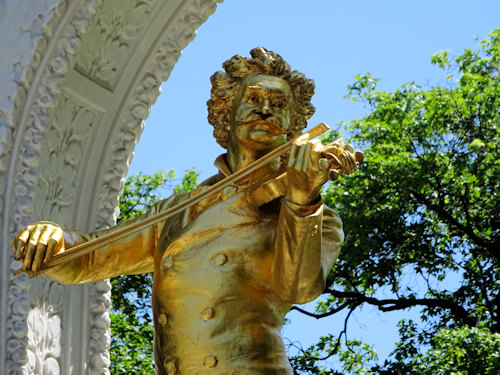
(The Golden Strauss statue makes an early appearance as the movie introduces the story)
The Third Man’s opening narration, for example, takes you on a whistle stop tour of city highlights that begins with a skeletal Stephansdom cathedral, still to be rebuilt after fire damage.
We see brief glimpses of, for example, the Strauss memorial, the top of the parliament building, the Beethoven statue, the Votivkirche (seen through the arches of the Rathaus), Schönbrunn Palace, Upper Belvedere palace, the Hoher Markt square with its distinctive Vermählungsbrunnen, and the Riesenrad Ferris wheel.
The action begins, though, with Holly Martins arriving in Vienna at the old Westbahnhof station (rebuilt in 1951 and again more recently). He goes to the apartment of his friend, Harry Lime.

(Harry Lime lived in this rather impressive place)
Ostensibly Stiftgasse 15 in the 7th district (according to Martins), the building is actually the rather majestic Palais Pallavicini on Josefsplatz square in the very centre of town.
The prominent Caryatids flanking the entranceway caused quite a stir when they first appeared in the 1780s.

(The shot we see when Holly Martins approaches Harry Lime’s apartment building)
The other sides of this historic square include part of the Hofburg residence of the Habsburgs, the Baroque state hall of the national library and the ancient Augustinerkirche church.
Inside Palais Pallavicini, Martins learns Lime is dead and hurries to the burial, which takes place in the Zentralfriedhof. In one shot, you can see the cemetery’s main church in the background.

(The church in the Zentralfriedhof)
The cemetery makes further appearances later in the film, for example when the police dig up Lime’s coffin.
Most people know the Zentralfriedhof because of the famous composer graves. The likes of Beethoven, Schubert, Brahms, and Strauss rest in peace here (as does, apparently, Harry Lime).
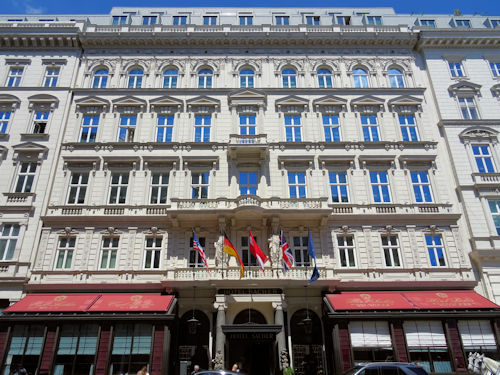
(Hotel Sacher, home to the Sachertorte and one-time home to Holly Martins)
Martins later takes a room at Hotel Sacher, initially paid for by the military police. If you want to spend the night there today, you may have to fork out a little more cash given its five-star status.
The Sacher continues to be a popular screen motif and plays, for example, a key role in the Sachertorte movie. And Maria Altmann stays here in the movie The Woman in Gold.
(The hotel even appears briefly in the Jack Ryan series.)
In the scenes of the lobby, a view through the hotel entrance shows the stone arches of the state opera house opposite.
At the hotel, Martins receives a call from Baron Kurtz, who he agrees to meet at Café Mozart.
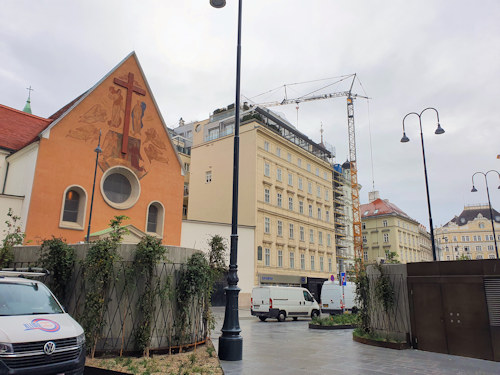
(Today’s view of Neuer Markt square from the movie’s location for Café Mozart)
The real Café Mozart is right next door to the Sacher, but the film version used a location just a little further away: the southern end of Neuer Markt square.
That square reopened back in 2022 after a huge refurbishment and underground garage project.
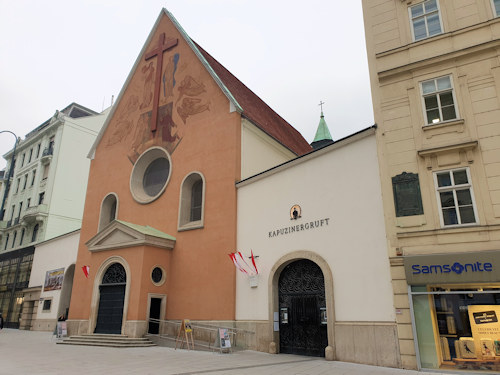
(We see the Capuchin church in the background of the café scene)
As Kurtz and Martins sit outdoors, you can spot the Capuchin church off to the left (home to the Kapuzinergruft or Imperial crypt).

(Harry Lime allegedly died at this very spot after his accident)
After coffee, Martins discusses Lime’s death outside the apartment with Baron Kurtz; we see a bit more of Josefsplatz and the base of the monument to Emperor Joseph II (pictured above).
Bars, theatres, and apartments

(Still putting on plays today)
Martin then tracks down Anna Schmidt (Lime’s actress girlfriend) at the Theater in der Josefstadt. Filming took place inside the real theatre, which still exists at Josefstädter Straße 26 and dates back to 1788.
After visiting Lime’s apartment again with Anna, our confused American takes the actress home to her apartment on Am Hof square. This is the shot:

(The modern office block where Anna Schmidt’s apartment building stood in The Third Man)
As you can tell from the photo, the apartment building no longer exists.
The replacement provides office space for an electricity company, so not quite as exciting as the rooms of a missing racketeer’s love interest.
In the background of the original and modern location, you can just about see the rich façade of the Bürgerliches Zeughaus, once home to a 16th-century armoury and now used by the local fire service.
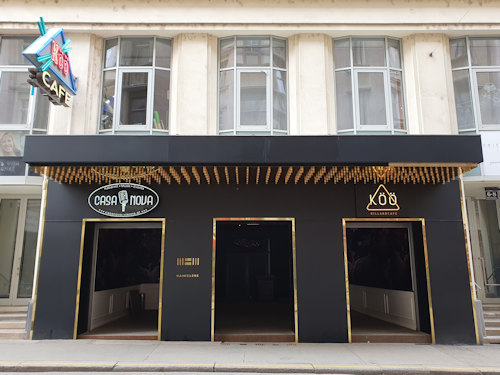
(Entrance to the club)
Another surviving (outdoor) location from these early scenes from The Third Man is the Casanova club at Dorotheergasse 6-8 in the centre of Vienna. Martins bumps into some of Harry Lime’s associates here while enjoying a drink with Anna.
Astonishingly, the club continues today, known for its cabaret and music events. Next door is Café Hawelka, a coffee house with an equally rich tradition.
Those same associates then meet up on the Reichsbrücke bridge: the only bridge across the Danube in Vienna that survived WWII intact.
The Reichsbrücke collapsed a few years later in 1976; fortunately, the timing meant only two vehicles were crossing the bridge at the time.
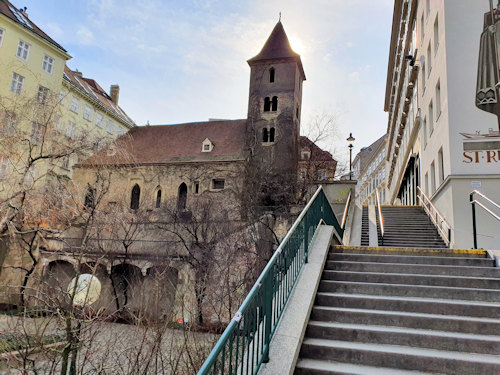
(Martins and Anna run down these steps away from a pursuing crowd)
We’re soon back at Palais Pallavicini, where Martins and Anna discover the porter has been killed. As the crowd turns suspicious, the pair flee the square.
You can see them running down the steps away from the Ruprechtskirche, a church with a 1000-year history.
The photo above doesn’t mimic the film entirely, since the current steps are further to the right than the ones that existed at the time of the Third Man.

(The former Heimat Kino and hideout for our fleeing couple)
Anna and Martins eventually hide out in a cinema: the Heimat Kino. The interior shots were also filmed on location there at Porzellangasse 19 (now the Schauspielhaus theatre).
Martin’s car tour
After returning to Hotel Sacher, Martins gets into a taxi that takes him on a hurried drive through the city. The fleeting scenes of passing buildings include the Minoritenkirche (twice, I think!).
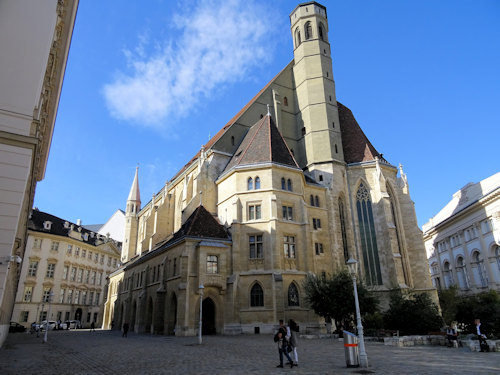
(Martins drives past the Minoritenkirche)
The car eventually deposits its guest at the Salesianerkirche at Rennweg 10, an abbey complex of the Salesian Sisters built in the early 1700s. In The Third Man, Martins is scheduled to give a talk on the modern novel there.

(The Salesianerkirche)
The complex’s neighbour is Lower Belvedere, part of the Belvedere palace and museum complex that includes the world-famous The Kiss painting by Gustav Klimt.
After the talk, Martins escapes from two unsavoury pursuers. One of the recognisable scenes involves climbing a long set of steps toward a church.

(Maria am Gestade church)
Not Ruprechtskirche this time, but Maria am Gestade, another Gothic church that used to be on the banks of the Danube until the Danube thought better of it and shifted away.
After eluding his pursuers, Martins eventually wanders off down a road leading away from Hoher Markt with the Vermählungsbrunnen in the background:

(Judengasse)
I couldn’t get the exact shot from any of the roads leading off Hoher Markt, but the street is almost certainly Judengasse. I imagine rebuilding work after the war saw exit streets from the square shift position a little.
The return of Harry Lime
When Martins next visits Anna, a view out of her apartment shows a figure hiding in the shadows of a doorway opposite. This door:
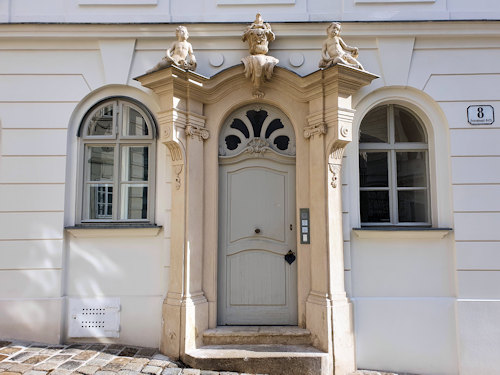
(The famous doorway at Schreyvogelgasse 8, where we first see Harry Lime)
At this point, I feel duty bound to point out that Anna’s alleged apartment on Am Hof square is nowhere near the view shown from the window.
On leaving the building, Martins challenges the figure, who turns out to be none other than Mr Lime returned from the dead. A chase follows around the corner up Mölker Steig.

(Martins and Lime hare off around this corner on to Mölker Steig)
Beethoven once lived nearby and The Third Man is not the only film to make use of this historical area.
The Vienna Blood period drama series, for example, shot several scenes here. As did the movie, Before Sunrise. And the chase scene in The Woman in Gold also uses these streets.

(Schulhof)
Martins’ pursuit now takes him elsewhere in the centre: down Schulhof and out into Am Hof square (a journey which would, ironically, take the pair toward Anna’s purported home and not away from it).
On the square, Harry Lime disappears.
We later learn he dropped into the sewers (the underground scene actually shows the River Wien where it flows under Vienna).
The column and door he uses to get below ground no longer exist. I assume they placed these as props to hide the Mariensäule column that would otherwise be in view. This is the same shot of the square today as you emerge from Schulhof:
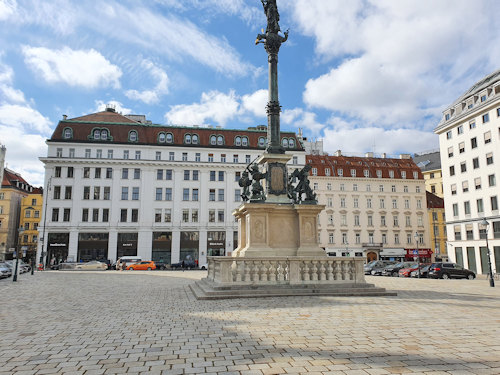
(Am Hof, where Harry Lime seems to disappear into thin air)
Ferris wheels and sewers
Now we can dive into the truly iconic scenes that dominate the end of the film.
The Riesenrad
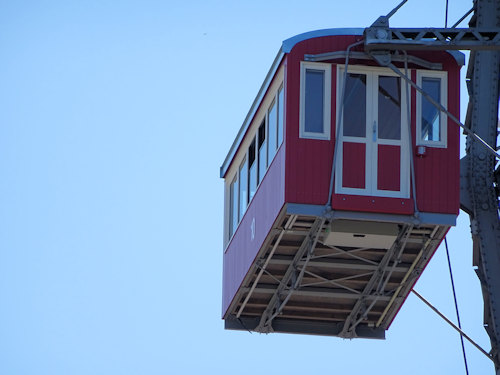
(One of the famous cabins)
Holly Martins visits the Baron, ostensibly near the Prater area of Vienna, and tells him he wants to meet Harry.
Martins waits for his resurrected friend by the carousel at the entrance to the Prater with the Riesenrad giant Ferris wheel behind him.
The two of them then participate in the famous scene in the Ferris wheel cabin, complete with a discussion of morality and the value of human life.
(The shots of the two actors inside the cabin were actually done in a London studio using a reconstruction. The Third Man museum has its own reconstruction you can use for photos.)
The Riesenrad remains one of Vienna’s most popular attractions, though a ride up in one of the cabins today involves slightly less threatening conversations and no open doors.
Incidentally, Madame Tussauds sits opposite, and one of the waxwork figures within is Orson Welles as Harry Lime in a suitable setting. Ideal for The Third Man selfies.
The sewers

(The Stallburg, where the deceptive shadow appears)
A few interior scenes later and we reach the final drama where the police use Martins as bait to bring Lime out into the open.
Martins waits for his friend in a café on Hoher Markt square. This whole area suffered considerable damage during the war, so today’s square bears no resemblance to what you see in The Third Man.
Officers lurk in the shadows around the base of the Vermählungsbrunnen fountain that’s popped up throughout the film.
At one point we see a shadow of a man appear on the side of a building. That building is actually the north side of the renaissance Stallburg that houses the stallions of the Spanish Riding School and sits just off Michaelerplatz square.
(Vienna Blood – mentioned earlier – has a homage to this scene in Episode 2 of Season 3.)

(The iconic entrance used by Harry Lime to access the Vienna sewers)
The chase that follows Lime’s appearance soon takes us into the Vienna sewers for one of cinema’s most renowned sequences.
That star-shaped sewer entrance that Lime climbs down is in the Girardipark just off Karlsplatz. Of course, you can’t actually go into the sewers and see those iconic underground locations.
Except you can…
Outside of winter, the city sewer authority actually offers a Third Man tour that takes you into that same entrance, where a short walk reveals the two locations used in filming.
Everything looks very much as it once did and makes for quite a fun experience.
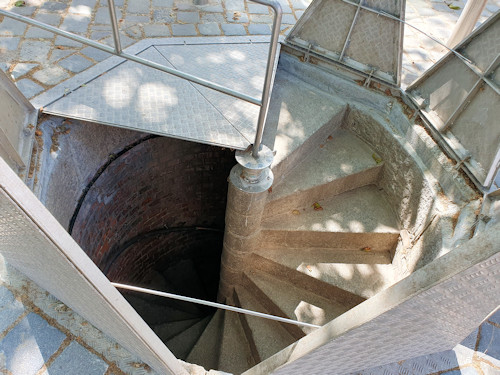
(Down you go…but only on an official tour)
And there you have it: a quick photo tour through the main The Third Man film locations. This map covers most of the places mentioned above, including that wonderful same-named museum featuring oodles of film memorabilia:
